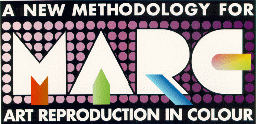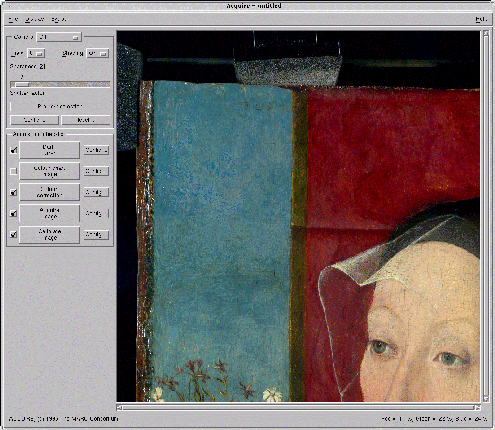The National Gallery - MARC - Art Reproduction in Colour
Since 1989 the National Gallery and Birkbeck College, London, have been engaged in a programme of research into museum imaging and its applications.
Until 1992 they were part of the ESPRIT II VASARI project which developed a scanner that could make highly accurate colour images at a resolution of 20 pixels mm-1 directly from the surface of the paintings.
Since 1992 they have been part of the ESPRIT III
MARC project which has developed a colorimetric digital plate camera capable of acquiring images of up to 20,000 by 20,000 pixels and a colour separation system which can accurately print these images on a conventional 4-colour press.
These imaging systems are used by the Gallery to conduct research into changes in appearance during conservation treatment, light-induced colour change of pigments, long-term colour
changes in paintings, infrared imaging and modelling of varnishes.

| |
The MARC camera achieves its high resolution with a combination of two different scanning principles: microscanning, which reduces the pitch
of the CCD sensor from 20µm to less than 3µm, and macroscanning, which increases the imaging area from 8.5mm by 6.5mm to about 60mm by 60mm. Pixel-synchronous 3 by 12-bit digitization at 10 MHz is done in the
camera head, eliminating line jitter and enabling a dynamic range of more than 3000 to 1.
|
Very good colour accuracy (approximately 2 just-noticeable-differences rms. in CIELAB colour space) is achieved by using integrated colour filters well-matched to the human visual system. The light sensitivity of the camera
can be increased by a factor of 50 by extending integration time. A dedicated SBUS interface card means that a full-resolution 1.7 GByte image can be acquired in as little as 5 minutes.
The hardware and the low-level software for the MARC camera has been developed by CCDV, a small German company based near Munich. They have drawn on their previous experience gained developing the camera marketed by Kontron as the ProgRes 3012.

The user interface for the camera has been developed at the National Gallery with X-Designer. "We've built several large Motif applications by hand," explained Dr. John Cupitt, the Gallery's software developer, "and
so we appreciated
how much time X-Designer saved us. The interface design is more attractive too, because X-Designer made it easy to experiment with layout and made it practical to attempt designs which otherwise would have been too time-consuming."
The interface produces images in TIFF CIELAB format. Images are automatically corrected for dark-current, shading, positioning errors, lighting fluctuations during exposure, and variations in illuminant temperature. They are equivalent in
quality to those produced by high-end transparency drum scanners, but have the advantage of not requiring colour correction in order to produce a good match between a reproduction and the original.
If you would like to know more
contact us by using our
enquiry form or
otherwise.
|